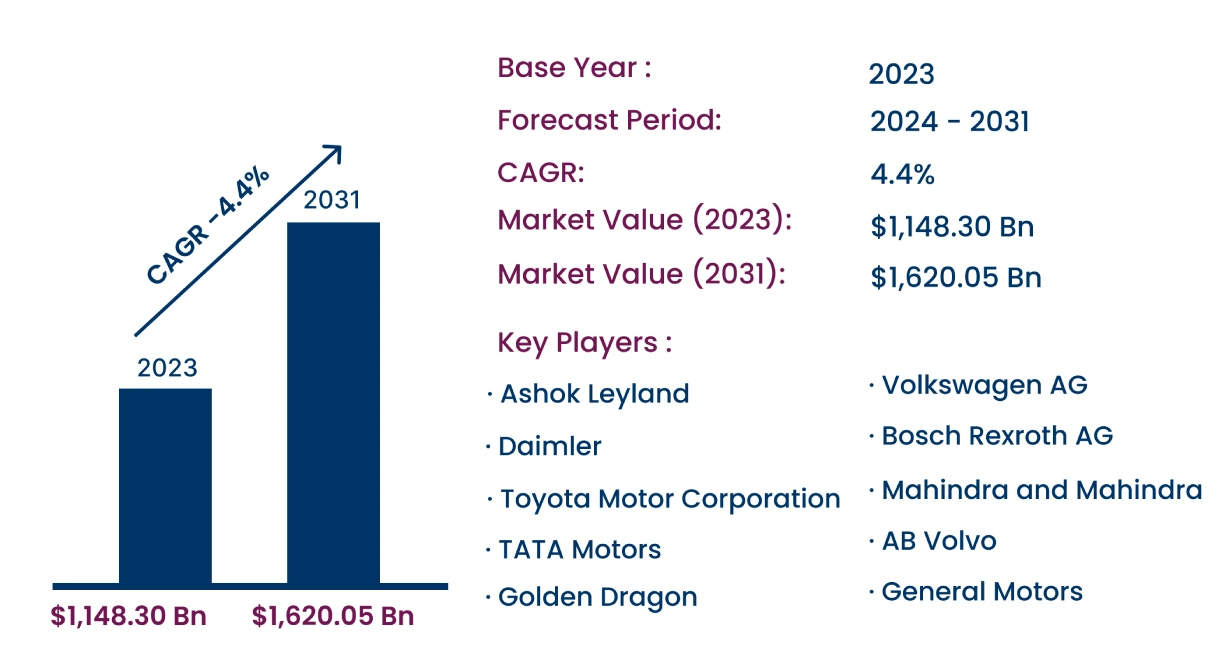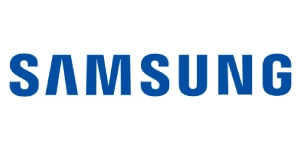Global Commercial Vehicles Market to Reach USD 1,620.05 Billion by 2031 | CAGR of 4.4%
Category : Automotive Services | Published Date : Oct 2024 | Type : Press Release
Commercial Vehicles Market Scope & Overview:
In the newly published report, Consegic Business Intelligence states that the Commercial Vehicles Market size was valued at USD 1,148.30 Billion in 2023 and is projected to reach USD 1,620.05 Billion by 2031, growing at a CAGR of 4.4% from 2024 to 2031. Commercial vehicles refer to vehicles utilized for transporting goods, materials, and passengers for commercial purposes rather than personal use. These vehicles are essential across various industries, including healthcare, automotive, and electronics, due to their ability to support logistics, manufacturing, and transportation needs efficiently.
The report comprises the Commercial Vehicles Market Share, Size & Industry Analysis, By Product (Light Commercial Vehicles (LCVs), Buses & Coaches, Heavy Trucks), Propulsion Type (IC Engine, Electric), Power Source (Gasoline, Diesel, HEV/PHEV, Battery Electric Vehicle (BEV), Fuel Cell Vehicle, LPG & Natural Gas), End-Use (Industrial, Mining, Construction, Transportation, Others), and By Region (North America, Europe, Asia-Pacific, Latin America, Middle East & Africa), and Forecast, 2024-2031.
The report contains detailed information on Commercial Vehicles Market Trends, Opportunities, Value, Growth Rate, Segmentation, Geographical Coverage, Company Profile, In-depth Expert Analysis, Revenue Forecast, Competitive Landscape, Growth Factors, Restraints or Challenges, Environment & Regulatory Landscape, PESTLE Analysis, PORTER Analysis, Key Technology Landscape, Value Chain Analysis, and Cost Analysis.
Rising adoption of telematics and fleet management solutions and increased demand for quick commerce are primary drivers of market growth. Additionally, the surge in electric commercial vehicles presents new growth opportunities.
Segmental Analysis :
Based on product, the market is segmented into light commercial vehicles (LCVs), buses & coaches, and heavy trucks.
- Light Commercial Vehicles (LCVs) held the largest share of 56.22% in 2023, driven by increased demand for urban logistics, e-commerce, and last-mile deliveries.
- Heavy trucks are expected to grow at the fastest CAGR, driven by their essential role in transporting heavy goods over long distances, especially in industries like mining and construction.
Based on propulsion type, the market is segmented into IC engine and electric.
- IC engine dominated the market in 2023, known for its robust power and efficiency in long-haul operations.
- Electric vehicles are expected to witness significant CAGR growth, fueled by environmental concerns, cost savings, and supportive government policies for EV adoption.
Based on power sources, the market includes gasoline, diesel, HEV/PHEV, BEV, fuel cell vehicles, and LPG & natural gas.
- Diesel accounted for the largest share in 2023, benefiting from high torque and the availability of fuel infrastructure for long-haul transportation.
- LPG & natural gas are expected to show notable growth as alternatives to traditional fuels, particularly in regions lacking extensive electric vehicle infrastructure.
Based on end-use, the market is segmented into industrial, mining, construction, transportation, and others.
- Transportation held the largest share in 2023, reflecting the demand for efficient urban and intercity logistics.
- Industrial applications are projected to grow at a significant CAGR, as commercial vehicles streamline production logistics and reduce operational costs in manufacturing.
Based on regions, the global market is segmented into North America, Europe, Asia-Pacific, Middle East & Africa, and Latin America.
- Asia-Pacific led the market in 2023, with a revenue of USD 413.49 Billion, driven by urbanization and infrastructure development, especially in China and India.
- North America is anticipated to grow at a high CAGR due to advancements in electric vehicle infrastructure and hybrid engine technologies in the U.S. and Canada.
| Report Attributes | Report Details |
| Study Timeline | 2018-2031 |
| Market Size in 2031 | USD 1,620.05 Billion |
| CAGR (2024-2031) | 4.4% |
| By Product | Light Commercial Vehicles (LCVs), Buses & Coaches, Heavy Trucks |
| By Propulsion Type | IC Engine, Electric |
| By Power Source | Gasoline, Diesel, HEV/PHEV, Battery Electric Vehicle (BEV), Fuel Cell Vehicle, LPG & Natural Gas |
| By End-Use | Industrial, Mining, Construction, Transportation, Others |
| By Region | North America(U.S., Canada, Mexico) Europe(U.K., Germany, France, Spain, Italy, Russia, Benelux, Rest of Europe) APAC(China, South Korea, Japan, India, Australia, ASEAN, Rest of Asia-Pacific) Middle East & Africa(GCC, Turkey, South Africa, Rest of MEA) LATAM(Brazil, Argentina, Chile, Rest of LATAM) |
Top Key Players & Competitive Landscape :
The competitive landscape encompasses major innovators, aftermarket service providers, industry giants, and niche players, all of which are thoroughly examined by Consegic Business Intelligence in terms of their strengths, weaknesses, and value-addition potential. This report includes detailed profiles of key players, market share analysis, mergers and acquisitions, resulting market fragmentation, and emerging partnership trends and dynamics.
List of prominent players in the Commercial Vehicles Industry:
- Ashok Leyland (India)
- Volkswagen AG (Germany)
- Bosch Rexroth AG (Germany)
- Toyota Motor Corporation (Japan)
- General Motors (U.S.)
- Daimler (Germany)
- Mahindra and Mahindra (India)
- TATA Motors (India)
- AB Volvo (SE)
- Golden Dragon (CN)
Recent Industry Developments :
- In May 2024, Tata Motors launched the all-new Ace EV 1000 for quick commerce, a zero-emission mini-truck with a payload capacity of 1 ton and a range of 161 km.
- In March 2024, Daimler announced the launch of 14 new products, including heavy-duty trucks for construction and mining, with advanced transmission systems.












